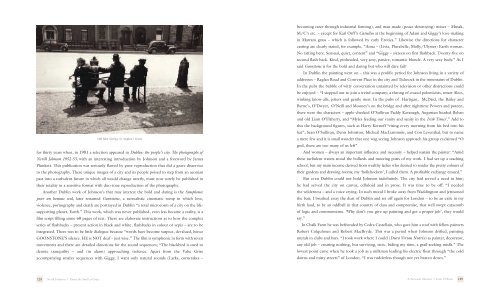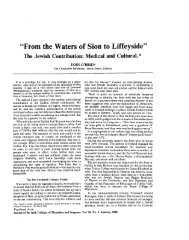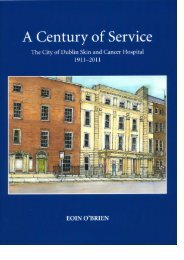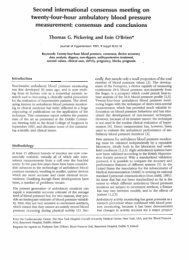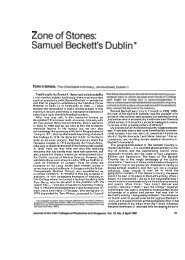Nevill Johnson: Paint the smell of grass - Eoin O'Brien
Nevill Johnson: Paint the smell of grass - Eoin O'Brien
Nevill Johnson: Paint the smell of grass - Eoin O'Brien
Create successful ePaper yourself
Turn your PDF publications into a flip-book with our unique Google optimized e-Paper software.
for thirty years when, in 1981 a selection appeared in Dublin: <strong>the</strong> people’s city. The photographs <strong>of</strong><br />
<strong>Nevill</strong> <strong>Johnson</strong> 1952-53, with an interesting introduction by <strong>Johnson</strong> and a foreword by James<br />
Plunkett. This publication was seriously flawed by poor reproduction that did a grave disservice<br />
to <strong>the</strong> photography. These unique images <strong>of</strong> a city and its people poised to step from an aeonian<br />
past into a turbulent future in which all would change utterly, must now surely be published in<br />
<strong>the</strong>ir totality in a sensitive format with duo-tone reproduction <strong>of</strong> <strong>the</strong> photography.<br />
Ano<strong>the</strong>r Dublin work <strong>of</strong> <strong>Johnson</strong>’s that may interest <strong>the</strong> bold and daring is <strong>the</strong> Symphonie<br />
pour un homme seul, later renamed Goonstone, a surrealistic cinematic romp in which love,<br />
violence, pornography and death are portrayed in Dublin “a total microcosm <strong>of</strong> a city on <strong>the</strong> lifesupporting<br />
planet, Earth.” This work, which was never published, even less became a reality, is a<br />
film script filling some 60 pages <strong>of</strong> text. There are elaborate instructions as to how <strong>the</strong> complex<br />
series <strong>of</strong> flashbacks – present action in black and white, flashbacks in colour or sepia – are to be<br />
integrated. There was to be little dialogue because “words have become suspect, devalued, hence<br />
GOONSTONE’S silence. HE is NOT deaf – just wise.” The film is symphonic in form with seven<br />
movements and <strong>the</strong>re are detailed directions for <strong>the</strong> sound sequences; “The blackbird is used to<br />
denote tranquility – and (in alarm) approaching violence. Apart from <strong>the</strong> Valse Grise<br />
accompanying smalzy sequences with Giggy, I want only natural sounds (Larks, corncrakes –<br />
128 <strong>Nevill</strong> <strong>Johnson</strong> l <strong>Paint</strong> <strong>the</strong> Smell <strong>of</strong> Grass<br />
Old Men Sitting, St. Stephen’s Green<br />
becoming rarer through industrial farming), and man-made (peace-destroying) noises – Musak,<br />
M/C’s etc. – except for Karl Orff’s Catullus at <strong>the</strong> beginning <strong>of</strong> Adam and Giggy’s love-making<br />
in Marram <strong>grass</strong> – which is followed by early Erotica.” Likewise <strong>the</strong> directions for character<br />
casting are clearly stated, for example, “Anna – (Livia, Plurabelle, Molly/Ulysses) Earth woman.<br />
No ratting here. Sensual, quiet, content” and “Giggy – sixteen on first flashback. Twenty-five on<br />
second flash-back. Kind, pinheaded, very sexy, passive, romantic blonde. A very sexy body.” As I<br />
said Goonstone is for <strong>the</strong> bold and daring but who will dare fail?<br />
In Dublin <strong>the</strong> painting went on – this was a prolific period for <strong>Johnson</strong> living in a variety <strong>of</strong><br />
addresses – Raglan Road and Convent Place in <strong>the</strong> city and Ticknock in <strong>the</strong> mountains <strong>of</strong> Dublin.<br />
In <strong>the</strong> pubs <strong>the</strong> babble <strong>of</strong> witty conversation untainted by television or o<strong>the</strong>r distractions could<br />
be enjoyed – “I stepped out to join a weird company; a throng <strong>of</strong> crazed polemicists, smart Alecs,<br />
winking know-alls, jokers and gentle men: In <strong>the</strong> pubs <strong>of</strong> Hartigan, McDaid, <strong>the</strong> Bailey and<br />
Byrne’s, O’Dwyer, O’Neill and Mooney’s on <strong>the</strong> bridge and after nighttime Powers and poteen,<br />
<strong>the</strong>re were <strong>the</strong> characters – apple-cheeked O’Sullivan Paddy Kavanagh, Augustan headed Behan<br />
and old Liam O’Flaherty, and “Myles feeding our vanity and sanity in <strong>the</strong> Irish Times’.” Add to<br />
this <strong>the</strong> background figures, such as Harry Kern<strong>of</strong>f “rising every morning from his bed into his<br />
hat”, Sean O’Sullivan, Denis Johnston, Micheál MacLiammóir, and Con Leventhal, but to name<br />
a mere few and it is small wonder that one wag seeing <strong>Johnson</strong> approach his group exclaimed “O<br />
god, <strong>the</strong>re are too many <strong>of</strong> us left”.<br />
And women – always an important influence and necessity – helped sustain <strong>the</strong> painter: “Amid<br />
<strong>the</strong>se turbulent waters stood <strong>the</strong> bollards and mooring posts <strong>of</strong> my work. I had set up a teaching<br />
school, but my main income derived from wealthy ladies who desired to render <strong>the</strong> pretty colours <strong>of</strong><br />
<strong>the</strong>ir gardens and drawing rooms; my ‘hollyhockers’, I called <strong>the</strong>m. A pr<strong>of</strong>itable exchange ensued.”<br />
But even Dublin could not hold <strong>Johnson</strong> indefinitely. The city had served a need in him;<br />
he had served <strong>the</strong> city on canvas, celluloid and in prose. It was time to be <strong>of</strong>f: “I needed<br />
<strong>the</strong> wilderness – and a voice crying. In such mood I broke away from Waddington and jettisoned<br />
<strong>the</strong> bait; I brushed away <strong>the</strong> dust <strong>of</strong> Dublin and set <strong>of</strong>f again for London – to be an exile in my<br />
birth land, to be an oddball in that country <strong>of</strong> class and compromise, that well swept catacomb<br />
<strong>of</strong> logic and commonsense. ‘Why don’t you give up painting and get a proper job’, <strong>the</strong>y would<br />
say.”<br />
In Chalk Farm he was befriended by Cedra Castellain, who gave him a ro<strong>of</strong> with fellow painters<br />
Robert Colquhoun and Robert MacBryde. This was a period when <strong>Johnson</strong> drifted, painting<br />
murals in clubs and bars. “I took work where I could (Dura Virum Nutrix) as painter, decorator,<br />
any old job – creating nothing, but surviving, stoic, biding my time, a grail-seeking misfit.” The<br />
lowest point came when he took a job as a milkman leading his electric float through “<strong>the</strong> cold<br />
dawns and misty streets” <strong>of</strong> London. “I was rudderless though not yet beaten down.”<br />
A Personal Memoir l <strong>Eoin</strong> O’Brien 129


